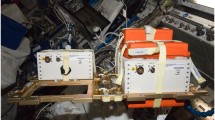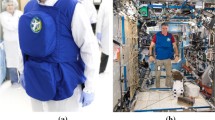Abstract
The paper presents the results of the calculation of cosmic ionizing radiation doses for conditions that simulate ISS crew quarters outfitted with additional protection in the form of a “protective shutter” kit used in the Matryoshka-R experiment; the kit is filled with high-pressure polyethylene instead of regular means of cosmonaut personal hygiene (wet wipes and towels). The calculation was performed using the ray tracing method, which was previously verified using the experimental data on the dose loads in the space station sections. The protective shutter kit has a thickness of 10 cm and covers the exterior wall of the crew quarters; its volume is filled with high-pressure polyethylene. The calculation is performed for the locations of experimental dosimetric assemblies for typical ISS orbits in the phase of minimum and maximum solar activity. The effect from the use of the additional protection (AP) in the ISS crew quarters in terms of the equivalent dose varies between 22 and 60% depending on the orbital altitude, phase of solar activity cycle, and initial conditions of protection. The results indicate a higher efficiency of the additional protection of polyethylene in comparison with water-containing materials. This AP from cosmic radiation has the potential to be used in long-term and long-range spaceflights.

Similar content being viewed by others
REFERENCES
Normy radiatsionnoi bezopasnosti (NRB-99/2009) SP 2.6.1.758-99 (Radiation Safety Standards (R-SS-99/2009): Sanitary Standards SP 2.6.1.758-99), Moscow: Federal’nyi tsentr gigieny i epidemiologii Rospotrebnadzora, 2009.
Shafirkin, A.V., Bengin, V.V., Bondarenko, V.A., et al., Dose loads and total radiation risk for cosmonauts in long-term flights on the Mir orbital station and International Space Station, Aviakosm. Ekol. Med., 2018, vol. 52, no. 1, p. 12.
Sanitarnye pravila i normy. SanPiN 2.6.1.44-03-2004. Metodicheskie ukazaniya MU 2.6.1.44-03-2004. Ogranichenie oblucheniya kosmonavtov pri okolozemnykh kosmicheskikh poletakh (OOKOKP-2004) (Sanitary Regulations and Standards. SanPiN 2.6.1.44-03-2004. Methodical Guide MU 2.6.1.44-03-2004. Limiting the Irradiation of Cosmonauts in Near-Earth Space Flights (OOKOKP-2004)), Moscow: Federal’noe upravlenie “Medbioekstrem,” 2004.
Mitrikas, V.G., Model for protecting the crew compartments of the service module of the International Space Station for evaluating the radiation hazard, Aviakosm. Ekol. Med., 2004, vol. 38, no. 3, pp. 41–47.
Sato, T., Niita, K., Shurshakov, V.A., et al., Evaluation of dose rate reduction in a spacecraft compartment due to additional water shield, Cosmic Res., 2011, vol. 49, no. 4, pp. 319–324.
Kodaira, S., Tolochek, R.V., Ambrozova, I., et al., Verification of shielding effect by the water-filled materials for space radiation in the international space station using passive dosimeters, Adv. Space Res., 2014, vol. 53, no. 1, pp. 1–7.
Kartashov, D.A., Tolochek, R.V., Shurshakov, V.A., and Yarmanova, E.N., Calculation of radiation loads in the module of the space station with the use of additional protection, Aviakosm. Ekol. Med., 2013, vol. 47, no. 6, pp. 61–66.
Temporary Sleeping Station (TeSS) in US LabModule. http://www.spaceref.com/news/viewpr.html?pid=24579.
Shavers, M., Zapp, N., Barber, R., et al., Implementation of ALARA radiation protection on the ISS through polyethylene shielding augmentation of the Service Module Crew Quarters, Adv. Space Res., 2004, vol. 34, no. 6, pp. 1333–1337.
GOST 16337-77. Polietilen vysokogo davleniya. Tekhnicheskie usloviya (GOST 16337-77. High-Pressure Polyethylene. Specifications), Moscow: Standartinform, 2008.
International Commission on Radiation Units and Measurements. Stopping Powers and Ranges for Protons and Alpha Particles, ICRU Report 49, 1993.
Kartashov, D.A. and Shurshakov, V.A., A new approach to calculating the shielding function for evaluating the radiation doses within the phantom in the space station module, Aviakosm. Ekol. Med., 2012, vol. 46, no. 6, pp. 55–61.
Kolomenskii, A.V., Characteristics of the radiation field in space, in Problemy kosmicheskoi biologii (Problems of Space Biology), Ugolev, A.M., Ed., Leningrad: Nauka, 1989, vol. 60, pp. 122–125.
Kodaira, S., Tolochek, R.V., Ambrozova, I., et al., Verification of shielding effect by the water-filled materials for space radiation in the international space station using passive dosimeters, Adv. Space Res., 2014, vol. 53, no. 1, p. 1–7.
Miroshnichenko, L.I. and Petrov, V.M., Dinamika radiatsionnykh uslovii v kosmose (Dynamics of Radiation Environment in Space), Moscow: Energoatomizdat. 1985.
FUNDING
The study is supported in part by the subject “Fundamental Scientific Research of the Russian Academy of Sciences no. 6000”.
Author information
Authors and Affiliations
Corresponding author
Additional information
Translated by M. Chubarova
Rights and permissions
About this article
Cite this article
Kartashov, D.A., Kartsev, I.S., Tolochek, R.V. et al. Calculation of Radiation Loads in a Space Station Compartment with Additional Protection of High-Pressure Polyethylene. Cosmic Res 57, 169–175 (2019). https://doi.org/10.1134/S0010952519030055
Received:
Revised:
Accepted:
Published:
Issue Date:
DOI: https://doi.org/10.1134/S0010952519030055




